Spanish Fencing Notation Part 2 – Footwork and the Circle
(8/24/2009)
In the Italian tradition there is an imaginary Line of Direction that describes the shortest path to the adversary.
The Spanish tradition uses this line and expands on the concept to create a 2D planar map of possible footwork laid out in a circle. The Spanish Circle is one of the defining elements of the science and various authors have presented it differently while preserving the core concept.
Carranza’s Circle
Here is the same image with labels to provide us a reference.
The Diameter – The imaginary line separating the two fencers is called the Diameter. It represents the shortest path to the target. The Diameter starts at the lead toe of the fencer (bottom of the red line) to the the lead toe of the adversary (top of the red line). The correct length of the Diameter should be the distance at which the fencer can observe the adversary’s offensive actions and still respond in time.
The Major Circle (Greater Circle) – The central circle shown between the two fencers is called the Major Circle or sometimes just the Circle. By rotating the Diameter about its center, we can create an imaginary circle which functions as a one piece of a footwork map.
The Lines of Infinity– The two parallel lines shown in green are called the Lines of Infinity or Infinite Lines. In the same manner as the Diameter, the distance between these lines is defined by your ability to observe and react to the adversary’s offense. Crossing the Line of Infinity means closing distance into the adversary’s offensive measure.
The Minor Circle – The smaller circles on either side of the Major circle are called the Minor Circles. The fencer and the adversary each stand in the center of a Minor Circle which is defined by the positions of the feet.
The Circle represents a moment of fencing time – The circle is not fixed in location, but instead describes the distance and possible steps within a specific fencing action. Just as the Italian Line of Direction changes when the adversaries move, so to does a new circle occur when the fencers change position. If an adversary has broken your defense and closed measure, the text may advise you to step onto a new circle and this represents the need to reestablish correct distance.
Pacheco’s Circle
Later Pacheco describes a similar circle. Note that the origin point for the fencer is at one end of the diameter (bottom of the circle) while the adversary stands on the opposite side (top of the circle).
The primary addition to the Circle is the Square which like the angular lines above in Carranza’s Circle provide us with another indicator for footwork.
We can also map a series of vectors onto this planar diagram which allows us to precisely describe footwork. Remember that a vector is a line with direction and magnitude.

A vector that indicates motion to the right of the reader. (This vector has an undetermined magnitude.)
General Notes
The Spanish treat a step as a motion that starts in stance and ends in stance which requires a motion of each foot. When the fencer moves only one foot, this is specified in the description of the footwork.
To compare this to Italian fencing, we know that an advance starts in the guard and requires a movement from the lead foot followed by the rear foot returning to the guard. Likewise a retreat starts in the guard and requires a movement from the rear foot followed by the lead foot returning to the guard.
By contrast, when an Italian fencer executes a lunge, the fencer starts in the guard and moves only the lead foot. The final position of the lunge is not the guard.
Forward Step
(En español – Compas Accidental )
The fencer advances along the line of the Diameter.
Backward Step
(En español – Compas Extraño )
The fencer retreats in line with the Diameter.
Lateral Step
(En español – Compas de Trepidacion)
The fencer steps along the Line of Infinity either to the left or right. When stepping towards a direction, unless directed otherwise, the fencer will avoid crossing the feet. For example, when stepping to the right, the fencer will lead with the right foot. When stepping to the left, the fencer will lead with the left foot.
Curved Step
(En español – Compas Curvo)
The fencer steps along the Circle either to the left or right. When stepping towards a direction, unless directed otherwise, the fencer will avoid crossing the feet. For example, when taking a Curved Step to the right, the fencer will lead with the right foot. When taking a Curved Step to the left, the fencer will lead with the left foot. At the completion of the Curved Step, the fencer should be in profile facing the adversary.
IMPORTANT NOTE: There is a misconception that stepping along the circle does not close distance. This is demonstrably incorrect as shown with this simple triangle in green, purple and blue overlaid on the circle.
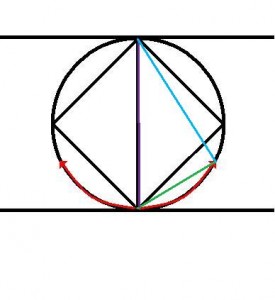
The blue line of the triangle demonstrates the Curved Step has gained measure. The blue line is clearly shorter than the Diameter.
If you step along the circle you should be aware that you have entered the adversary’s range. Walking along the circle without reason provides your adversary with one unit of fencing time with each step and I don’t recommend it.
A Curved Step along the circle is a common method of gaining ground gradually and is often used in response to an offensive action from the adversary.
For example, if the adversary executes a cut, we may intercept the attack with the blade and then step forward along the circle to deliver a riposte. Because the adversary has moved forward already, our step moves only slightly forward and takes us off the line. After we have delivered a riposte, we might back away safely past the Line of Infinity.
Transverse Step
(En español – Compas Transversal)
The Transverse Step is a type of angular advance either to the left or right along the square shown inside the circle. The Transverse starts with the lead foot and is followed by the rear foot. At the completion of the Transverse Step, the fencer should be in profile facing the adversary. When there is an exception to this, it is stated in the description of the step and may be called a Mixed Step (See below).
The Transverse Step closes distance more aggressively than the Curved Step shown above and is typical of offensive actions or attacks into the adversary’s preparation.
Mixed Step
(En español – Compas Mixto)
A Mixed Step is a combination of two other types and are often angular retreats either to the left or right away from the circle.
Two common examples of Mixed Steps are Mixed Backwards and Lateral to the left or Mixed Backwards and Lateral to the right. In this case, the Mixed Step starts with the rear foot and is followed by the lead foot. At the completion of the Mixed Step, the fencer should be in profile facing the adversary.
Another common Mixed Step is the Transverse Step to the Left using the right foot, followed by a Curved Step with the left foot.
This image is my copy of a Circle from Ettenhard’s book in 1675 which describes the footwork.
1. The lead foot takes a Transverse step along the square pre-turning the lead foot to point back to the adversary. (The weight rests on the ball of the lead foot.)
2. Pivoting on the ball of the front foot, the rear foot moves in an arc landing on the adversary’s Line of Infinity.
3. The lead foot passes behind the left executing another pivot and placing the fencer in profile with respect to the adversary on his Line of Infinity.
Other Footwork
Other footwork is explicitly described in the text.
For example:
The Italian gaining step would be described as “bringing the rear foot forward close to the heel of the right foot.”
The Italian lunge would be described as “an extreme forward step of the lead foot while keeping the rear foot fixed.”
Opposition of Footwork
According to Ettenhard,
- The Forward Step is superior to the Backward Step
- The Forward Step is defeated by the Transverse, Curved, Lateral, and Mixed Backward and Lateral Steps. (Stepping off the Line of Direction will defeat an advancing opponent.)
- The Transverse and Curved Steps can be defeated with the Transverse and Curved Steps. (When an adversary circles toward you, either moving into them or circling away can defeat their action.)
Application to other Traditions
Again this material can be tradition agnostic. Using the Spanish Circle as a footwork map provides us with a useful guide for describing to a student how fast we want them to close measure. We can also advise the student to step inside the square or outside of it provide more nuance.
In addition, the Spanish codify angular and circular footwork which has been largely excluded from modern fencing traditions. As Ettenhard states, countering a circular step with a circular step is a good solution and we see this understanding in Destreza, Aikido, and many other martial arts.



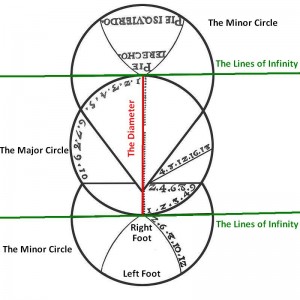
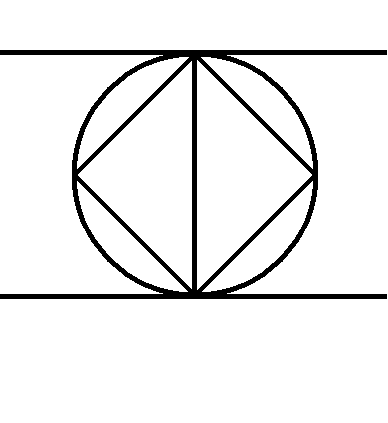
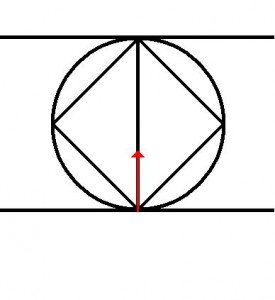
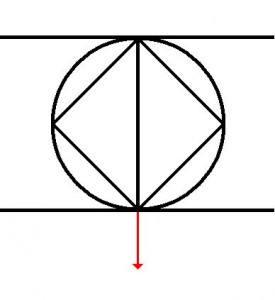
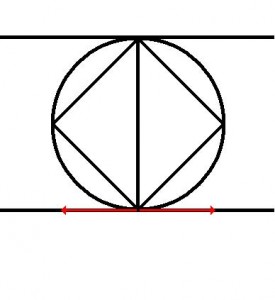
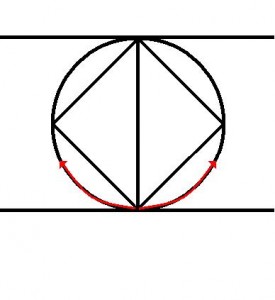
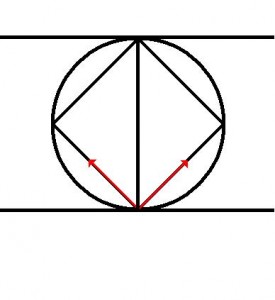
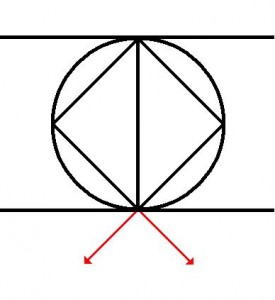
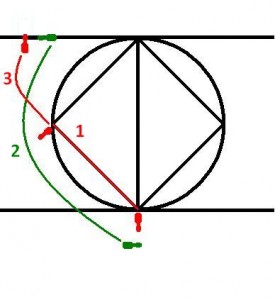
Good timing, and well done Puck. I believe I will be pointing several people to these two posts over the next month, as the explanations are clear, and well written. One question if I may: Are you planning on including the next part as the magnitude of the vectors? Which would then touch on Medio Proporcionado, Paso geometrico?
By Ramon Colon on August 27, 2009 4:39 pm
Hola Ramon,
I have just posted an article on Medio Proporcionado and the Medio de Proporcion. The magnitude of the vectors is qualitative. How far do you need to go to achieve your goal? How long are your arms and your pace?
For example in Ettenhard’s case, he specifies how far back you should bring the arm to deliver a more powerful half cut (direct cut).
~P.
By puck on September 1, 2009 6:44 pm
Hola Puck,
This has to do with that question on the paso geometrico, doblado etc, since Pacheco defines it as each having so many ‘feet’, and even Tamariz defines each Medio Proporcionado in terms of the compas and the size of it(Tamariz page 45-46). Now, I agree, it is dependent on lengths, and such, but then why the measurements given by the authors?
I would hazard to say more like a starting point, under ‘ideal’ conditions, to describe the depth and deviation of each path of movement? The Spanish tailors gave lengths in the basic patterns, and then each garment was fitted to the individual. Perhaps this is the same mentality?
Just some thoughts, as I move to sort this part out.
Keep those posts and works coming! I have more people to point your way soon!
Ramon
By Ramon Colon on September 2, 2009 6:27 pm
Hola Ramon,
I think that is a fair criticism and I agree with your thought that this is an idealized Medio Proporcionado just as our Medio de Proporcion is often demonstrated with identical opponents and identical weapons. Ettenhard is interesting because rather than a fixed Medio de Proporcion, you have already seen his more qualified version above based on the ability to observe and react to a threat.
He also states in Chapter IV, “I consider determining a fixed distance for the Steps to perform the propositions as extremely difficult (and even impossible) because since the distances are in proportion, the Skilled Swordsman shortening his Step as much as the opponent had lengthened his. And because lengthening or shortening it is as much in the one as in the voluntary and not a necessary Act, a fixed point cannot be given to what cannot have one, as one moves five feet, it can be four or one.”
I like this nuance, but a more rigid definition can also be useful.
~P.
By puck on September 2, 2009 10:23 pm
Hola Puck,
At least something to consider, as long as we don’t get too tangled up in the minor details. I figure with more time working on this, it will reveal its place. At least for me, his Paso Sencillo is dead on in length. I need to grab my copy of Ettenhard then and have a look.
Thanks,
Ramon
By Ramon Colon on September 3, 2009 8:42 pm
Hola Ramon,
Looking at Ettenhard again, the Geometric Step (Double Step), Simple Step, and “passada” are exactly what Ettenhard is referring to here:
“I consider determining a fixed distance for the Steps to perform the propositions as extremely difficult (and even impossible) because since the distances are in proportion, the Skilled Swordsman shortens his steps as his opponent lengthens his. And because the lengthening or shortening it is as much in the one as in the other a voluntary and not necessary Act, a fixed point cannot be given to what cannot have one. Only in one case could it be obtained, and it is if one of the Combatants did not move from his spot, since due to not altering the distances, fixed distances could be proposed for the practice of the Steps. But it is well known how unlikely is the consideration of an immobile opponent, with which I confirm my opinion even though our Master don Luis Pacheco de Narvaez gave them three measures for their distinction named the double step or Geometric Step, Simple Step, and “passada”. He attributed the double to five feet in length, one solid (that is where the foot came to rest) and four empty ones; the the simple three, one solid and two empty ones; and to the “passada” two, one solid and the other empty. With all it is not enough so they cannot be formed of six, four or one. With which I say absolutely that only the knowledge and ability of the Combatants will be able to measure the distances proportionately, having as a general rule that if the opponent makes long Steps, the Skilled Swordsman should make short ones, the one making up for the disproportion of the other and the perfection in the method of forming them will be achieved.”
~Ettenhard (T2.C4)
That is from Ettenhard’s book in the Second Treatise, Chapter 4 – Of the Definition of the Step and Its Types.
I hope that helps. I’ll crack Pacheco’s Grandeza and look at the relevant text there as well.
~P.
By puck on September 4, 2009 8:42 pm
I’m having difficulty visualizing the difference between a curved step and a transverse step. Also, the mixed backward and lateral step to the left could just be a backwards tranverse step, could it not?
Video of these would be helpful for those of us who are spacially challenged.
By CH7 on September 5, 2009 6:54 am
A Transverse step is also forward and to one side. It always begins with the lead foot. It is a step along the Square which closes more distance towards the adversary than a Curved Step. This makes the transverse step ideal for offensive and counteroffensive actions like attacks into preparation.
Unless otherwise specified, the Curved step will begin with the foot that corresponds to the direction of the step.
Curved left = left foot then right foot
Curved right = right foot then left foot
Curved steps take place along the Circle and cover less forward distance than the Transverse. The curved step is often used during a riposte or during counteroffense.
*************
Transverse steps are only forward. In one of my initial footwork papers I described Transverse steps forward AND backward. A Spanish friend of mine shot me an e-mail correctly pointing out the error. That isn’t the way the Spanish authors notate the actions so while it might make explaining things a bit less verbose, it would be changing or corrupting a term. That’s a big no-no. Translating a term into English is one thing. Changing the meaning of a term or adding new terms is a bad idea.
If all transverse steps are forward and we incorrectly describe an angular retreat as a “transverse” a reader later could come to exactly the wrong conclusion about a technique in the original document.
By puck on September 6, 2009 1:01 am
“Transverse steps are only forward. In one of my initial footwork papers I described Transverse steps forward AND backward. A Spanish friend of mine shot me an e-mail correctly pointing out the error. That isn’t the way the Spanish authors notate the actions so while it might make explaining things a bit less verbose, it would be changing or corrupting a term.”
Ah, ok. Understood.
I’m enjoying playing around with the footwork so far although I’m sure I’m botching some of it. It’s different, but kind of fun at the same time.
Look forward to reading more of your articles in the future.
By AF1 on September 6, 2009 3:28 am
Sorry to come across as harsh on that one, but I had already hit it.
It might be more correct to say that we could consider the transverse a form of mixed step because it has both a forward and lateral motion. Because the Transverse is a very important step in the tradition and it makes sense that it has a special name.
If you want to practice a sequence of steps try this one:
1. Bring the left heel onto the Line of Infinity even with the right toes
2. Take a Transverse step with the right foot to the left side placing the weight on the ball of the right foot
3. Pivoting on the ball of the right foot, take a circular step left with the left foot that passes all the way to the adversary’s line of infinity
4. Finish the footwork with a circular step with the right foot to the left side onto the Line of Infinity so that you are profiled with the adversary with a left foot lead on his line of Infinity.
For an image see the Mixed Transverse & Curved step above and pre-load it with the left foot as I mention here in step 1.
By puck on September 7, 2009 6:02 am
OK TO YOU TRANSLATION.YOU UNDERSTOOD IT.CONGRATULATIONS
By IESUVINCIT on October 14, 2009 10:40 am
[…] LINK TO ARTICLE 2 […]
By Spanish Fencing Notation Part 5 - Strength of the Weapon | A Midsummer Night’s Blog on November 3, 2009 7:00 pm